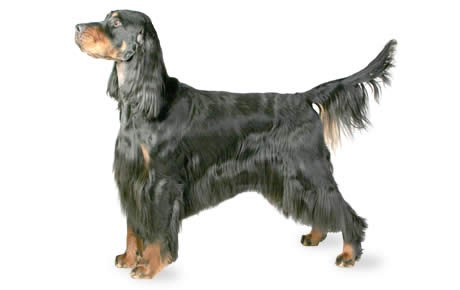Gordon Setter Breed Guide

Breed Group:
Sporting Dogs
Get 30% off
Join our Newsletter
Sign Up Today
Gordon Setter History
Skilled in both the field and on the hunting grounds, the Gordon Setter is an impressive athlete and a loving companion. Originating in Scotland back in the 1600’s, this breed served as a trusted hunting partner due to their incredible sense of smell and strong intuition.
It wasn’t until 1842 that the first Gordon Setter made its way to the United States. It would take almost 50 years until the American Kennel Club recognized them as an official breed. Today, the Gordon Setter is a relatively popular breed that is praised for their protective and determined qualities.
Gordon Setter Personality
With a youthful spirit and an independent personality, the Gordon Setter is one of a kind. Although they may be stubborn at times, they are still intensely loyal to their family and will do anything to keep them happy. Since this breed can be hesitant and distrustful towards strangers, they serve as excellent watchdogs, ready to alert their family at the first sign of an intruder.
Gordon Setter Training
When it comes to dog training, the Gordon Setter needs a firm and guiding owner to reaffirm proper behavior. However, make sure you’re not too harsh since this breed tends to be quite sensitive and may develop depression or anxiety. Use calm commands with positive reinforcement when training your Gordon Setter.
Most professionals would recommend an experienced owner for this breed. Since the Gordon Setter has a stubborn streak, they can be difficult to train when following a command. In fact, when given the opportunity, the Gordon Setter will try to call the shots in a household, and ignore their owner if not properly trained. If you are having troubles training your pup, try enrolling him in puppy obedience courses.
Gordon Setter Exercise Needs
The Gordon Setter is an energetic breed that needs daily activity to keep them happy and healthy. They serve as the perfect jogging partner, and can easily keep up with the endurance of their owner. Aside from daily walks and runs, try participating in field competitions. Not only will this challenge them mentally and physically, but it’s also a great way for you to bond with your furry companion.
Gordon Setter Lifespan
On average, the lifespan of a Gordon Setter is around 10 to 12 years.
Gordon Setter Breed Popularity
Due to their large size and stubborn tendencies, the Gordon Setter has gained little popularity in the United States. Today, the American Kennel Club has ranked the Gordon Setter as the 104th most popular dog breed in the U.S.
Gordon Setter Feeding Requirements
The Gordon Setter has an appetite that matches their massive size. On average, this breed needs 2 to 3 cups of high-quality food a day, split into two separate meals. Keep in mind that this is dependent on their size, metabolism, activity level, and age. Contact your veterinarian for further nutritional guidance.
Gordon Setter Grooming
When properly groomed and maintained, the Gordon Setter showcases a majestic coat that is long and soft. In order to keep their coat tangle free, brush them out a couple times a week.
This will also help to prevent matting and any loose hairs from accumulating. Aside from their coat, their eyes and ears should be checked regularly for infection. Also be sure to trim their nails and brush their teeth often. If you can hear your pups nails tapping on the hardwood floor, that means it’s time for a trim.
Gordon Setter Good with Kids?
The Gordon Setter is patient and playful towards children, but are too large for toddlers to handle. If there are children within the home, make sure they know how to properly treat and interact with a large animal. No matter what, a parent should always be present during any interactions between a child and pet.
Gordon Setter Health Problems
Gastric Dilatation-Volvulus (Bloat): This life-threatening condition is known to affect large, deep-chested dog breeds. Bloat in dogs occurs when the stomach expands with gas or air, causing it to put extra pressure on nearby organs. The stomach will then twist and restrict the dog from being able to rid their body of the extra gas. In severe cases, blood flow may become restricted to the heart, leading to further complications or even death.
Hypothyroidism: Hypothyroidism in dogs occurs when the body is unable to create enough thyroid hormones from the thyroid gland. When this occurs, a dog may experience a fluctuation in weight, a decrease in energy, or a change in their coat. Luckily, a synthetic hormone pill can alleviate a dog from their symptoms.
Hip dysplasia: This hereditary condition is quite common in larger dog breeds. Hip dysplasia in dogs occurs when the thighbone and hip socket do not properly fit together, causes lameness, pain, and eventually arthritis.
Other Resources
National Breed Website: Gordon Setter Club of America
Rescue: Gordon Setter Rescue
